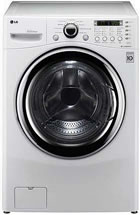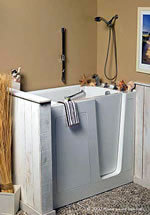|
Volume 20, No. 1 – Winter 2012 |
Subscribe to AT Messenger Download PDF Viewer |
| PDF Version (for printing) Large Print (PDF) Text Version |
Technical Innovations and Independence:
Living Comfortably, Independently and Safely at Home
Dan Fendler
AT Specialist, DATI Sussex County ATRC
Technology touches virtually all areas of our lives. And because the cost of many technologies has come down quite significantly, wonderful options are now affordable.
The rapid advance of technology has boosted the ability for all people to live fuller, richer and more independent lives. In this article, we will explore some of the areas in which technology can help people live more independently. We’ll learn about useful and affordable “Smart Home” technology and ideas. We will also look at low–cost tips to help maximize your independence. (Please note: commercial products mentioned in this article are for illustrative purposes only. We make no claims and are not endorsing any of the products mentioned here.)
Appliances
Let’s take a look at some of the innovations available in today’s appliances, starting in the laundry room. Everyone needs clean clothes. Whether you have a disability or are just getting older, “doing the laundry” involves a number of steps. Typically, you load the washer, wait for it to finish, transfer the clean, wet clothes to the dryer, wait for them to dry and then fold. If you could eliminate the need to transfer the clothes from the washer to the dryer, then the chore would be a little bit easier.
 Front load
washer/dryer
Front load
washer/dryerUntil recently, there weren’t many affordable options to simplify this chore. Today, there are a number of combination washer/dryers that eliminate the need to transfer the clothes from one machine to the other. And they are available at a relatively low price. One example is the LG WM3987HW (see photo). Note that it is front loading, which is easier to access for some people. Many of the combination units do not require external venting and they also plug into a standard 110v outlet (unlike most stand–alone electric dryers that require a 220v electrical source). Be aware that there is a tradeoff with non–venting units: While they do not require 220v outlets or additional venting, Front load they may require additional washer/dryer time to run a complete laundry cycle. In fact, it may take considerably longer than drying in a traditional dryer. Because there are so many commercial options available, you might want to compare features of various products. The computer is great for that; just type “combination washer dryer” into your Internet browser’s “search” window. If you don’t have access to a computer or Internet or you have questions, please feel free to call your local ATRC for assistance.
 Under-counter, two-drawer dishwasher
Under-counter, two-drawer dishwasherMoving on to the kitchen, here’s an idea that may help a number of folks. After a recent back injury, I noticed how heavy the dinner plates were as I struggled to move the clean plates from the dishwasher to the cabinet. Curiosity got the better of me, so I actually weighed the plates. I was surprised to learn that the entire stack weighed over 28 pounds! What if you could eliminate the need to put the dishes away? With the creative use of a drawer–style dishwasher, you can. With a two–drawer system, you can use one drawer for clean dishes and the other for dirty dishes, eliminating the need to ever stow the dishes in a cabinet.
The placement of appliances can also be important. When building or redesigning your kitchen, consider how and where built–in appliances are placed. There are a variety of under–the–counter refrigerators available. The strategic placement of ovens and microwaves can also help facilitate access. Also consider slide–out cabinet shelves. Sliding shelves can make access to cabinets much easier for everyone.
Home Automation
A variety of home automation equipment can facilitate independent living. Automation can enhance independence by increasing safety and security, enabling effortless control of the environment and providing peace of mind to concerned loved ones.
Video cameras inside and outside your house can add to a sense of security. They can be accessed from the Internet and may help family members keep a watchful eye on aging relatives living alone. A Panasonic BL–C131A Network Camera is one product on the market. (Note: Web cameras require high speed Internet access, which involves a monthly fee.)
There are a number of ways you can control your home environment (including lights, appliances and security systems). Here are a few examples:
- From your smartphone
- From a computer
- From specialized remotes, touchscreen panels or specialized light switches
- From outside your house
- Automatically, based on personal or seasonal schedules
- Automatically, based on other “events”–doors opening or motion sensors being activated
- One at a time or all together.
Notifications
Notification systems can also increase a sense of security. A notification system is defined as the combination of hardware with a software program that is capable of sending messages to a pre–defined set of recipients. For example, the woman on the infamous “Help, I’ve fallen and can’t get up” commercial wore a small, wireless transmitter that sent a signal to a device connected to her telephone line. The system was preprogrammed to automatically contact a support center that would subsequently contact the individual needing help. If need be, the support center staff would contact local emergency responders.
Before deciding on a particular notification system, you should do some research. A quick search of the Internet shows that there are a few vendors with a number of complaints. Find out if the company you are considering has a high number of complaints against it. Understand the contract terms and do not enter an agreement with unreasonable restrictions or potential penalties (e.g., early termination fees). A simple Internet search might provide valuable information. Again, if you don’t have access to a computer and/or would like more information, please contact your local ATRC for assistance.
Additional Considerations
 Walk-in bathtub
Walk-in bathtubThere are numerous ideas that can help people remain safe in the bathroom. An Internet search for “safety in the bath” produces many options–grab bars, accessible tubs, bath benches, transfer boards and many other items. The important thing to remember is that falls are serious events, and every precaution should be made to reduce the risk of a fall ever happening.
GPS (Global Positioning Systems) can be used to track individuals who have a tendency to wander (such as people with Alzheimer’s). While these systems hold promise for some, they generally are only available as part of an ongoing service and involve monthly service fees. There is a free system that can be installed on some smartphones, but it has limited abilities. If you are interested in learning more about one of these systems, check out the Alzheimer Association’s Comfort Zone® at www.alz.org/comfortzone/.
Project Lifesaver (www.projectlifesaver.org) may also be helpful. According to their website, the primary mission of Project Lifesaver is to provide timely response to save lives and reduce potential injury for adults and children who wander due to Alzheimer’s, autism and other related conditions or disorders.
Low–Cost Tips
Here are a few practical, low–cost tips to promote independence and safety:
- Simplify your environment; keeping organized can help reduce accidents.
- Avoid stairs.
- Use your car alarm as a notification system. Carry your keyless car remote with you at all times, and let your neighbors know to call for help if your car alarm sounds.
- Prevent falls; put grab bars and non–slip mats in the bathroom.
- Improve lighting in areas where you might fall.
- Store frequently used items in easy–to–reach spots.
- For added security, carry a charged cell phone with you, even at home.
- Use timers for irons, coffee pots and other appliances needed for short periods that can cause injury or property damage if left unattended for too long.
- Arrange to call a friend or relative on a schedule. Let them know to call for help if they don’t hear from you.
- Highlight uneven surfaces with contrasting colors.
On a recent trip to a local big box store, I noticed a display called “Lowe’s Accessible Home™,” which included a few accessible products, including a walk–in bath. There is a guide available with a number of practical ideas, along with an accessibility checklist that is worth checking out. The guide is available on the Internet at the following URL www.lowes.com/cd_accessible+home_133799062_.
There are literally dozens of new technologies that carry the potential of helping many people lead more independent lives. If you would like to learn more about available technology that may meet your needs, please feel free to contact your local ATRC.

